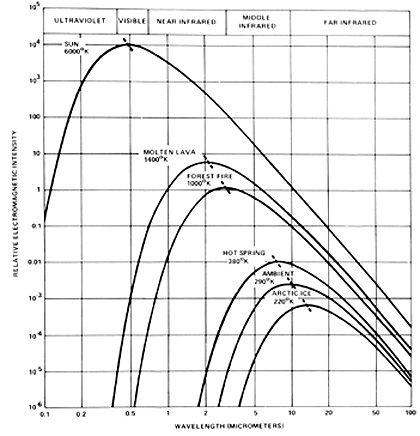The Wien Displacement Law and Emissivity Effects¶
Contents
This page reviews several of the fundamentals of thermal behavior of materials. The Wien Displacement Law demonstrates that peak radiative intensity will occur at different wavelengths depending on the temperature of the radiating body. The concepts of emissivity and of blackbody radiation are discussed. A diagram shows that the radiant temperature measured by a sensor will vary considerably if emissivities are sharply different, even if the different bodies have similar kinetic temperatures.
The Wien Displacement Law and Emissivity Effects¶
The above figure (also shown on page 8-8) plots spectral wavelength versus emitted radiance (as intensity) from thermal radiators at various peak radiant temperatures ranging from that of the Sun to the Earth’s surface (average ambient temperature and sea ice). The hotter the radiating body, the greater is its radiance (intensity on the ordinate) over its range of wavelengths, and the shorter is its peak emission wavelength. The relation between peak wavelength and radiant body temperature is the Wien Displacement Law:
λ **m** T = 2898
where λ **m** is the wavelength at maximum radiant emittance and T is the absolute temperature in degrees Kelvin (°C + 273). The constant, 2898, is in units of µm °K. It is also given as (rounded off) 0.29 cm °K. For the Sun, with a photospheric radiant temperature of about 6000 °K, this peak is in the visible (centered on 0.58 µm). A forest fire peaks around 5.0 µm. The Earth, as observed from space, peaks within the 8-14 µm interval.
` <>`__9-1: What is the peak wavelength for a lamp that glows at 1800° C? `ANSWER <Sect9_answers.html#9-1>`__
A parenthetical comment about the Sun’s color, as human’s see it. We perceive it as yellow-orange but from the above diagram its peak is within the green visible range. Why then doesn’t it appear green? The answer relates to the eye’s response to a mix of colors. For the Sun all visible colors are emitted, with green slightly dominant. To an astronaut in orbit above the atmosphere, the Sun appears almost white - a mix of all visible light waves. Steel heated to 6800 °C would glow in a near white color. But on Earth the astronaut’s retina would describe it as orange, since his eye cannot separate the stronger influence of green from adjacent wavelengths in the different colors since all have nearly the same intensity. (For the Sun to actually glow as a green incandescent body, the wavelengths on either side of the green region would have to be much less intense, i.e, depart from a radiant Black Body.) The orange results from subtraction of blue and blue-green owing to selective scattering of those wavelengths - hence they are largely removed, shifting the color into orange. Even that color varies, as the Sun extends low above the horizon after dawn or around sunset, since the greater density of air as one looks near the horizon causes further scattering, leading to a more reddish Sun (which also seems larger, as does the Moon near the horizon, owing to refraction-controlled bending differences).
The quantity of radiant emission, and thus the effective temperature
that is measured externally as radiation, also depends on the emissivity
ε (the small Greek letter “epsilon”) of the object in the spectral
region of interest. Emissivity is a dimensionless number that expresses
the ratio of the radiant flux of a real material FR to the
radiant flux of a perfect blackbody FB (one that completely
absorbs incoming radiant energy, with none being partitioned into
transmitted or reflected components), or FR/F:sub:B = ε
.It is a measure of the efficiency of emitted radiance of any real body
to that of a perfect radiator (for which ε = 1.0). Values of ε
vary from 0 to 1 and are spectrally dependent, i.e., can change with
 . Here is an example comparing the spectral radiant emittance of
the common mineral quartz to a perfect blackbody when they are at
thermal equilibrium at a given temperature (here, at 600 °K).
. Here is an example comparing the spectral radiant emittance of
the common mineral quartz to a perfect blackbody when they are at
thermal equilibrium at a given temperature (here, at 600 °K).
From T.M. Lillesand and R.W. Kieffer, Remote Sensing and Image Interpretation, 2nd Ed., © 1987. Reproduced by permission of J. Wiley & Sons, New York.
The sharp decrease in ελ in the 8-10 µm region, noted for quartz and other silicates, is a “reststrahlen” effect (decreased emission) related to thermally induced stretching vibrations within silicon-oxygen bonds. In general, for opaque materials, ε :sub:`λ` = 1 - ρ :sub:`λ` , where ρ (Greek rho) is the material’s optical reflectance. Therefore, as ρλ —-> 1, with high reflectance of radiation (poor absorptance), the emittance will be lowered (thus, thermal radiation decreases). Water, which has a high emissivity in the thermal infrared in the 8-10 µm interval, is a poor reflector over that range; quartz (and many silicate rocks) is a good emitter at lower thermal wavelengths but poor in this interval. From this, one might predict that rock surfaces would appear darker than water in the 8-10 µm interval but this holds only for certain conditions, as we will shortly see.
The radiant (sensed) temperature TR differs from a body’s kinetic (internal) temperature TKaccording to the relation T:sub:`R` = ε :sup:`1/4` T:sub:`K` ;as stated above, for real bodies (graybodies) radiant temperatures are always less than kinetic temperatures. Thus, checking the figure below, the radiant temperature is significantly higher for a blackened surface (high ε ) than for a shiny surface (lower ε ), even if the two materials are at the same kinetic temperature.
From F.F. Sabins, Jr., Remote Sensing: Principles and Interpretation. 2nd Ed., © 1987. Reproduced by permission of W.H. Freeman & Co., New York City.
` <>`__9-4: For the real body we considered in question 9-3, what is its radiant temperature? `ANSWER <Sect9_answers.html#9-4>`__


